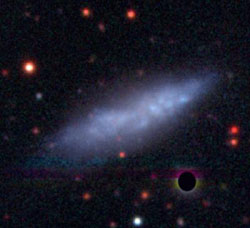New insights into the 'hidden' galaxies of the universe

The galaxy ESO 546G-34 is small faint and unevolved low surface brightness galaxy of dwarf-type, which makes it somewhat similar to the Small Magellanic Cloud (companion galaxy to the Milky Way) in appearance. ESO 546G-34 has an extremely low abundance of heavier elements and contains at least 50 percent gas, which also makes it similar to the small galaxies that were abundant in the early universe. Credit: ESO<br>
The galaxy has lower amounts of heavier elements than other known galaxies of this type. The discovery means that small low surface brightness galaxies may have more in common with the first galaxies formed shortly after the Big Bang than previously thought. The results have been published in Monthly Notices of the Royal Astronomical Society.
As the name implies, the galaxies are faint and therefore difficult to find and challenging to observe. The galaxy called ESO 546-G34 is a nearly 20 year old observation that no one had previously taken much notice of. The observation has now been analysed using new methods and it is only now that astronomers have realised how special it is.
“The galaxy gives us an idea of how the galaxies must have looked before star formation really got going”, explains Lars Mattsson, an astrophysicist at the Dark Cosmology Centre at the Niels Bohr Institute, University of Copenhagen. The discovery was made in collaboration with astronomers at Uppsala University and the Astronomical Observatory in Kiev.
The evolution of galaxies
A galaxy consists of many millions or billions of stars. Stars are formed when giant gas clouds condense and form a ball of glowing gas – a star. A star produces energy through the fusion of hydrogen into helium, which fuses into carbon and oxygen and further into heavier and heavier elements. The process of conversion from gases to heavier elements takes anywhere from hundreds of thousands of years to billions of years.
Most of the known galaxies that have only formed small amounts of the heavy elements are young galaxies that are undergoing gigantic outbursts of star formation. This makes them incredibly bright and easier to observe. One type of galaxy with bursts of star formation is called blue compact galaxies, as newly formed stars emit a bluish light.
'Unevolved' dwarf galaxy
The galaxy that has been observed is small and contains only extremely small amounts of the heavier elements. That it consists mostly of the gases hydrogen and helium and is so faint means that it has only just begun to form stars.
“Our analysis shows that while a large, mature galaxy like our own galaxy, the Milky Way, is comprised of around 15-20 percent gas, this faint little galaxy is comprised of up to 50 percent gas and is very poor in heavier elements. This means that it is very unevolved”, explains Lars Mattsson.
The theory is that the very small faint galaxies collide with each other and the greater concentration of gas material and dynamical disturbance boosts star formation and thereby form the larger blue, compact galaxies.
“ESO 546-G34 is a left over dwarf galaxy that doesn't seem to have collided with other galaxies. This gives us unique insight into how the earliest galaxies in the universe may have looked”, explains Lars Mattsson.
http://arxiv.org/abs/1105.3650
Contact: Lars Mattsson, astrophysicist, Dark Cosmology Centre, Niels Bohr Institute, University of Copenhagen, 3532-5927, mattsson@dark-cosmology.dk
Nils Bergvall, Professor, Uppsala University, 018 471 59 75, nils.bergvall@fysast.uu.se
Media Contact
More Information:
http://www.nbi.dkAll latest news from the category: Physics and Astronomy
This area deals with the fundamental laws and building blocks of nature and how they interact, the properties and the behavior of matter, and research into space and time and their structures.
innovations-report provides in-depth reports and articles on subjects such as astrophysics, laser technologies, nuclear, quantum, particle and solid-state physics, nanotechnologies, planetary research and findings (Mars, Venus) and developments related to the Hubble Telescope.
Newest articles

Silicon Carbide Innovation Alliance to drive industrial-scale semiconductor work
Known for its ability to withstand extreme environments and high voltages, silicon carbide (SiC) is a semiconducting material made up of silicon and carbon atoms arranged into crystals that is…

New SPECT/CT technique shows impressive biomarker identification
…offers increased access for prostate cancer patients. A novel SPECT/CT acquisition method can accurately detect radiopharmaceutical biodistribution in a convenient manner for prostate cancer patients, opening the door for more…

How 3D printers can give robots a soft touch
Soft skin coverings and touch sensors have emerged as a promising feature for robots that are both safer and more intuitive for human interaction, but they are expensive and difficult…





















